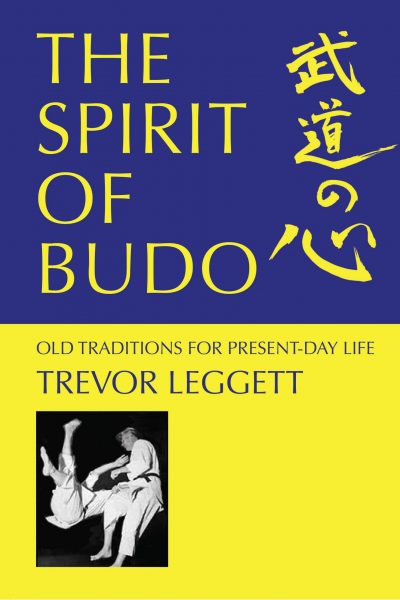The Spirit of Budo

Book description
This book comprises eighteen essays which appeared in the monthly Budo magazine. They are written with simplicity and humour, but with an underlying discipline and authority derived from a lifetime of spiritual and martial arts training in Adhyatma Yoga, Judo and Zen. Trevor Leggett addresses matters including sportsmanship, achieving freedom of mind, training the inner self, developing an inner calm, and the four keys to learning – instruction, observation inference and personal experience. He looks at the cultivation of these Budo qualities and suggests ways in which the lessons learned can be applied to daily life as well as to the practice of the martial arts.
Paperback published by TLAYT
ISBN 9781911467175
Price £9.99
eBook published by TLAYT
ISBN 9781911467182
Price £5.99
Book extract
Yin and Yang in Budo In some texts of traditional schools of Budo like the Itto-ryu 5, there is a distinction between the Budo of yin and the Budo of yang. I first heard about this from a Judo teacher, long before I could read the Budo texts. It confirmed an impression that had been growing in me that there are two kinds of Budo. This is the sort of thing that some of the traditions taught: Before a combat, the swordsman of yin is perfectly calm. His expression does not change; he does not defy the enemy. He does not stare at the opponent wide-eyed or try to intimidate him with feints. He does not come forward with little steps, as if crossing a single-plank bridge, but he walks as if on a wide road, with a perfectly normal posture. This is a master who can hardly be defeated. The swordsman of yang, on the other hand, has an expression which would seem to crush rocks, has an aggressive posture, stares wide-eyed and tries to intimidate the opponent by feints and glaring at him. He advances and retreats awkwardly; his heart is agitated and he is weak. One of the texts added, I remember, that the yin fighter can, if necessary, imitate the fury of the yang. But inwardly he remains calm. From my first introduction to the ideas of Budo, I have been mentally dividing the practice, pictures, texts and traditions into two kinds of Budo. I used to think of them as Narrow Budo and Wide Budo.
Book Review
The Spirit of Budo is a somewhat unusual book in that it is a collections of essays about the martial arts and other aspects of traditional Japanese culture written by a foreigner, published in the most prestigious of the Japanese martial arts periodicals, Budo, the monthly publication of the Nippon Budokan. Imagine–an Englishman telling the Japanese about budo. It’s like a Japanese discussing baseball with Americans or cricket with the British. Those sports are ours–what could this guy possibly know? Trevor P. Leggett, though, is a most unusual and qualified person in this area of Japanese culture. He is one of the most senior non-Japanese judoists in the world, having begun his study of the art in 1930. Prior to World War II, he spent several years living and training in Japan while stationed at the British embassy. After military service he joined the BBC, rising to become the head of its Japanese Service. Since retiring, Leggett has written extensively on the martial arts, as well as Zen and shogi (Japanese chess), both of which are areas in which he is eminently qualified. These essays are the distillation of more than six decades of intense study, with a number of the best teachers in the world, by a thoughtful and insightful man.
The essays are divided into four broad themes. The first section, “Bujin and the Gentleman,” includes the essays “The Spirit of Budo,” “Sincerity,” “Spectators,” “Yin and Yang in Budo,” and “Inner Calm.” “Old Traditions Breathe Fire Into Present-day Life” covers such topics as chivalry, world culture, generosity, humor, and technical training. In the third section of the book, “Budo: Learning for Life” Leggett discusses the idea of musha shugyo in “Travel and Learn,” different methods of learning in “The Four Keys to Learning,” how one or two succinct comments made at the right moment can change a person’s life in “Dynamic Words,” and some of the intangible aspect of martial arts training in “Free from Fixed Ideas.” The final portion of the book is “Dr. Jigoro Kano and Judo.” Here, the author discusses at length some of budo’s most important precepts. The first essay, “The Buddhist Ideal of Mutual Benefit,” examines one of judo’s most basic maxims, jita kyoei, and should prove very useful for everybody in budo. “Bunbu Ryodo,” the second piece in this chapter, is a succinct examination of the interdependence of literary study and martial discipline. “Judo in Real Life” can be extended to any and all of the martial arts or other disciplines referred to in Japanese as seishin shugyo (austere training). The last essay, “The Will to Make it Happen,” returns to an earlier topic and examines some of the mental and spiritual sides of martial arts study.
There are several instances in this volume, where the written English seems a bit cumbersome. I am not sure whether this is because Leggett wrote in Japanese and the translator used less felicitous phrasing, or if the essays were intended for non-native readers of English. I suspect that the former is true, having read a number of the author’s other books. In any case, there are parts of these essays that resonate and bear reading and consideration over an extended period. I found myself thinking, “Oh! So that’s what (So-and-so) Sensei meant!” all through the book. It’s worth keeping.
Meik Skoss